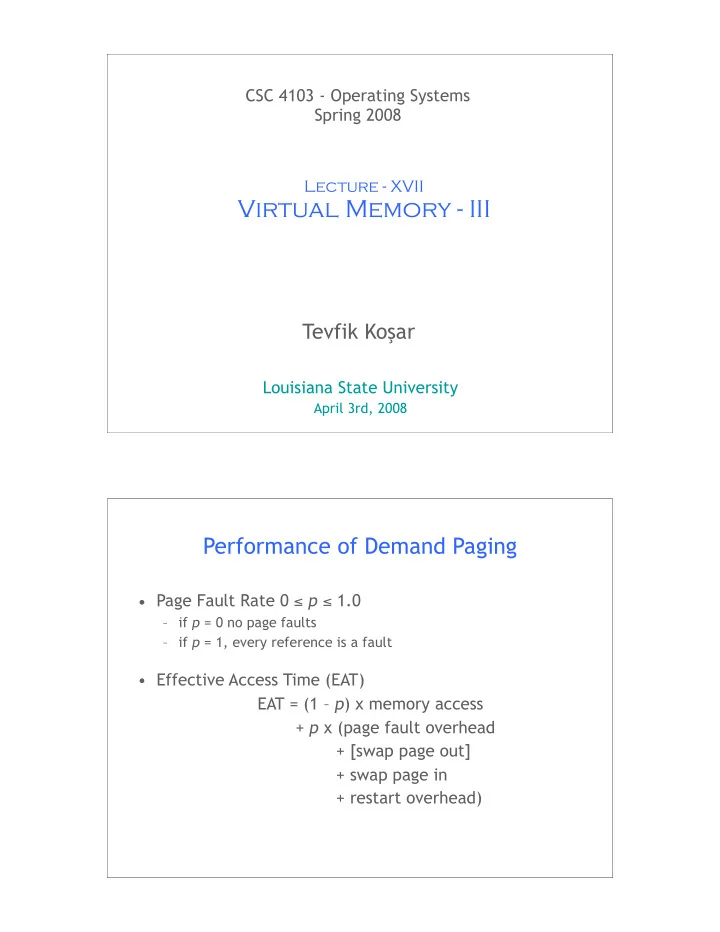

CSC 4103 - Operating Systems Spring 2008 Lecture - XVII Virtual Memory - III Tevfik Ko � ar Louisiana State University April 3rd, 2008 1 Performance of Demand Paging • Page Fault Rate 0 � p � 1.0 – if p = 0 no page faults – if p = 1, every reference is a fault • Effective Access Time (EAT) EAT = (1 – p ) x memory access + p x (page fault overhead + [swap page out] + swap page in + restart overhead)
Demand Paging Example • Memory access time = 1 microsecond • 50% of the time the page that is being replaced has been modified and therefore needs to be swapped out • Swap Page Time = 10 msec = 10,000 microsec • EAT = (1 – p) x 1 + p x (10,000 + 1/2 x 10,000) = 1 + 14,999 x p (in microsec) • What if 1 out of 1000 memory accesses cause a page fault? • What if we only want 30% performance degradation? Exercise • Assume we have a demand-paged memory, with memory access time 1 milliseconds. It takes 10 milliseconds to service a page fault if an empty page is available or the replaced page is not modified, and 20 milliseconds if the replaced page is modified. Assume that the page to be replaced is not modified 60 percent of the time. What is the maximum acceptable page- fault rate for an effective access time of no more than 5 milliseconds? 4
Solution • 5 > (1-p)*1 + p*(0.6*10+0.4*20) • 5 > 1-p+14p • 5 > 1-13p • p < 4/13 • p < 0.30 5 Thrashing • If a process does not have “enough” frames, the page-fault rate is very high. This leads to: – Replacement of active pages which will be needed soon again � Thrashing � a process is busy swapping pages in and out • Which will in turn cause: – low CPU utilization – operating system thinks that it needs to increase the degree of multiprogramming – another process added to the system
Thrashing (Cont.) Page-Fault Frequency Scheme • Establish “acceptable” page-fault rate – If actual rate too low, process loses frame – If actual rate too high, process gains frame
Allocation of Frames • Each process needs minimum number of pages • Example: IBM 370 – 6 pages to handle SS MOVE instruction: – instruction is 6 bytes, might span 2 pages – 2 pages to handle from – 2 pages to handle to • Two major allocation schemes – fixed allocation – priority allocation Fixed Allocation • Equal allocation – For example, if there are 100 frames and 5 processes, give each process 20 frames. • Proportional allocation – Allocate according to the size of process
Priority Allocation • Use a proportional allocation scheme using priorities rather than size • If process P i generates a page fault, – select for replacement one of its frames – select for replacement a frame from a process with lower priority number Global vs. Local Replacement • Global replacement – process selects a replacement frame from the set of all frames; one process can take a frame from another • Local replacement – each process selects from only its own set of allocated frames
Acknowledgements • “Operating Systems Concepts” book and supplementary material by A. Silberschatz, P . Galvin and G. Gagne • “Operating Systems: Internals and Design Principles” book and supplementary material by W. Stallings • “Modern Operating Systems” book and supplementary material by A. Tanenbaum • R. Doursat and M. Yuksel from UNR 13
Recommend
More recommend